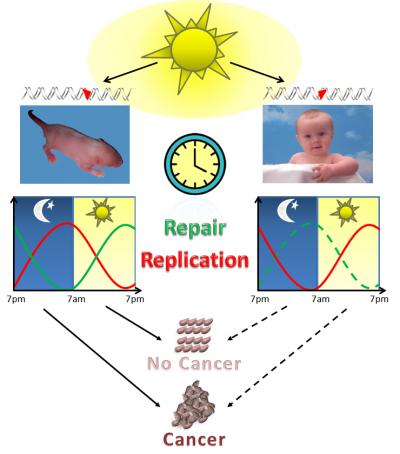Another reason to run in the morning
Your body's ability to repair damage from UV rays peaks early in the morning, then declines through the day.
Runners and cyclists (and walkers and open-water swimmers and so on) spend a lot of time outdoors. Which is great — for me, that’s one of the big attractions! Still, that’s a lot of UV exposure, which is a bit worrying. But a neat and surprising study from researchers at the University of North Carolina, published in the Proceedings of the National Academy of Sciences, suggests that UV exposure in the morning is much less damaging than an identical dose of UV exposure later in the afternoon. This has nothing to do with cloud cover or sunlight intensity — it’s all about the body’s circadian rhythms.
The problem with UV light is that it damages your DNA; your body fights this ongoing damage by trying to repair the DNA. The levels of a key protein responsible for this repair process fluctuate during the day, with a maximum early in the morning and a minimum late in the afternoon. In contrast, the process of DNA replication, which can cause the errors in damaged DNA to spread, is slowest in the morning and fastest in the afternoon. So UV damage in the morning should be less likely to spread and more quickly repaired; in the afternoon, it’s the opposite. Here’s an illustration from the study’ s press release (you’ll notice that mice, which are nocturnal, have exactly the reverse pattern):

So does this effect have any real practical significance? Well, the researcher tested it on mice. They exposed two groups of mice to identical doses of UV radiation, one at 4 a.m. and the other at 4 p.m. The morning exposure group was five times more likely to develop skin cancer than the afternoon exposure group. (Remember that mice have the opposite cycle compared to humans, so that means morning is the best time to be exposed for humans.)
Is this sufficient evidence to tell people to switch up their exercise patterns? Not really. The researchers are now planning to directly measure DNA repair rates in human volunteers at various times, which would be another plank. For now, the timing of my workouts (which are, in fact, mostly in the morning) is dictated by lots of other factors — but it’ll make me worry a little less about the tan lines that I develop even when I’m running super-early in the morning. Now I just need a study that tells me that vitamin D production is maximized by morning sun exposure, and I’ll be all set!


